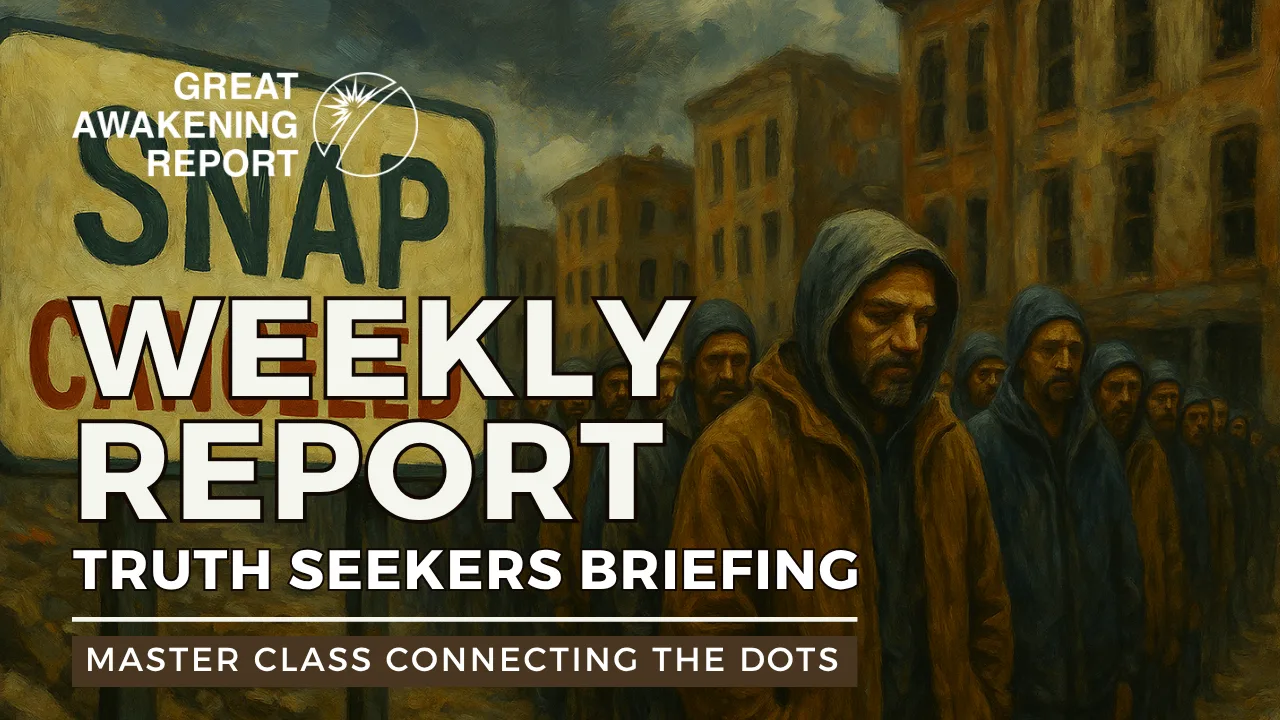Introduction: Understanding the Crisis
The current state of America’s food supply system is showing alarming signs of distress, primarily driven by recent plant shutdowns due to various factors, including labor shortages, weather-related disruptions, and ongoing geopolitical tensions. According to experts, the shutdown of key agricultural processing plants has significantly disrupted supply chains, leading to shortages and increased prices for essential food items. A report highlights that food sectors such as meat processing have been particularly vulnerable, experiencing interruptions that ripple through the entire supply chain, affecting farmers, distributors, and consumers alike [Forbes].
The urgency surrounding these shortages cannot be overlooked, as projections indicate that without timely intervention, the U.S. could face severe food insecurity. A joint report by the USDA and other agricultural agencies notes that if plant shutdowns continue, they could lead to a major crisis within the next year [Source: Nature]. Furthermore, given the volatility of current food supply networks, experts advocate for immediate reforms aimed at improving resilience against such disruptions. Streamlining logistics, investing in local food systems, and enhancing labor conditions are essential steps to mitigate the impacts of these ongoing challenges [Nature].
Through these efforts, the hope is to stabilize the food supply, ensuring that shortages can be averted and access to essential foods remains reliable for all Americans. Addressing these issues not only requires a comprehensive understanding of the complexities involved in food distribution but also a determined commitment to foster sustainable practices within the agriculture sector.
The Ripple Effect: What Causes Plant Shutdowns?
Manufacturing plants across various industries are significantly impacted by an array of factors leading to shutdowns, particularly in the context of recent global disruptions. Beyond immediate shortages, these shutdowns expose the risks of over-centralization in food processing. When a handful of plants control much of the nation’s output, any disruption cascades through the entire chain.
Labor Shortages: One notable factor is the ongoing labor shortages exacerbated by the COVID-19 pandemic. Industries are grappling with insufficient workforce levels, driven by a combination of retirements, health concerns, and changing workforce demographics. A report by the National Association of Manufacturers indicated that over half of manufacturers report difficulties in finding qualified workers, which directly contributes to operational inefficiencies and increased likelihood of temporary shutdowns [NAM].
Supply Chain Disruptions: Supply chain issues remain another critical cause of plant shutdowns. The pandemic highlighted vulnerabilities within global supply networks, with many manufacturers experiencing delays in obtaining raw materials and components. A survey by Deloitte notes that more than 60% of manufacturers faced disruptions due to suppliers’ challenges, leading to halted production lines and significant financial losses [Deloitte].
Regulatory Challenges: Additionally, evolving regulatory environments can impose abrupt changes that affect manufacturing operations. Companies often face increased compliance requirements which can necessitate adjustments to production processes or even lead to temporary shutdowns while they adhere to new regulations. The complex landscape of environmental regulations, labor laws, and trade policies can hinder operational stability [Forbes].
By understanding and navigating these challenges, manufacturers can better prepare for and mitigate future shutdown risks, ensuring more resilient operations in an increasingly uncertain global landscape.
Economic Impacts: The Cost of Shortages
Food supply interruptions significantly disrupt economic stability and inflate food prices, affecting both consumers and producers across the supply chain. Plant shutdowns, often triggered by unforeseen events such as natural disasters, labor strikes, or health crises, create a domino effect leading to scarcity. According to a recent study, regions that experienced such shutdowns saw food prices rise by approximately 20-30% due to decreased supply and increased transportation costs [Source: Nature].
Consumers are immediately impacted by these price hikes, which result in higher grocery bills and reduced purchasing power. Low-income households are particularly vulnerable, as they allocate a larger portion of their income to food. This can lead to increased food insecurity, causing a rise in hunger and malnutrition, especially among children. A report from the Food and Agriculture Organization (FAO) indicated that global food insecurity climbed significantly during supply chain disruptions, exacerbating health crises in affected populations [Forbes].
On the producer side, the economic repercussions can be devastating. Farmers are left with unsold perishable inventory, leading to losses that can threaten their viability. Many rely on government assistance or subsidies during times of crisis, further straining public resources. The ripple effects extend to various sectors, influencing job security within the agricultural community and related industries, ultimately contributing to broader economic instability. As demand continues to outstrip supply, a cycle of inflation and deficits emerges that can take years to resolve [Nature].
Agricultural Innovations: Solutions on the Horizon
Innovative agricultural practices and technologies are emerging as critical solutions to enhance food production resilience and mitigate shortages caused by global disruptions.
Vertical Farming is one such innovation that uses controlled environments to grow crops in stacked layers. This method significantly reduces land use and environmental impact while maximizing yield. Studies suggest that vertical farms can achieve up to 10 times the production of traditional farming methods, making them suitable for urban areas with limited space [Forbes].
Precision Agriculture, utilizing IoT sensors and data analytics, allows farmers to monitor crop health and manage resources more efficiently. By analyzing data from soil moisture and climate conditions, farmers can optimize irrigation and fertilization, thereby enhancing yields and conserving resources. Recent advancements in soil moisture datasets, leveraging satellite technology, aid farmers in making data-driven decisions to improve crop management [Nature].
Sustainable practices, like regenerative agriculture, focus on restoring soil health and enhancing biodiversity, further contributing to food security. These methods include crop rotation, cover cropping, and reduced tillage, promoting a resilient food system capable of withstanding future shocks.
As global challenges mount, adopting these innovative agricultural solutions can help secure a stable food supply, improve resilience, and promote sustainable practices across the industry.
Consumer Awareness: How to Navigate the Shortage
### Meal Planning
- Plan Meals Ahead: When faced with food shortages, planning meals for the week can help maximize the use of available ingredients. Focus on versatile staples such as rice, beans, and pasta that can be combined with various vegetables and proteins to create multiple dishes. Aim for a balance of nutrients by including fruits and vegetables whenever possible, utilizing high-preservation options like frozen or canned [Nature].
- Batch Cooking: Cook in bulk to save time and effort. For instance, prepare large portions of soups, stews, or casseroles that can be refrigerated or frozen for later use. This approach not only conserves energy but also ensures you have meals ready on busy or unexpected days when access to food might be limited.
- Flexibility with Recipes: Adapt recipes based on what ingredients are in stock to reduce waste. For example, if a recipe calls for zucchini but it’s unavailable, substitute it with carrots or bell peppers. This adaptability is crucial when certain staples are hard to find [Nature].
### Sustainable Shopping Practices
- Buy Local: Support local farmers and artisans by sourcing produce directly from farmers’ markets or community-supported agriculture (CSA) programs. Local food not only reduces transportation emissions but is often fresher and more nutritious compared to store-bought alternatives [Forbes].
- Choose Seasonal Produce: Opt for fruits and vegetables that are in season, which are usually more affordable and available. Knowing seasonal crops can help you make better purchasing decisions and minimize reliance on imported goods.
- Utilize Bulk Bins: Purchase staples from bulk bins to minimize packaging waste and buy only what you need. This practice is particularly effective for grains, nuts, and dried beans, supporting both sustainability and budget-friendly shopping.
### Alternative Sources for Staples
- Community Gardens: If possible, participate in a community garden. These spaces not only provide fresh produce but also build community connections and encourage sustainable gardening practices. If space permits, consider starting your own garden at home with easy-to-grow vegetables like tomatoes, lettuce, and herbs.
- Foraging: Learn local foraging techniques to identify edible plants and mushrooms. This ancient practice can supplement your diet with unique nutrients while promoting a deeper connection to your environment [Nature].
- Online Resources and Groups: Utilize online platforms and local food networks, which often share tips on where to find alternative sources of food staples or barter goods and services with neighbors. Engaging with community groups online can help tap into shared resources during hardships.
Implementing these strategies can significantly help consumers navigate food shortages while also promoting sustainability and resilience in times of need.
Call to Action: Ensuring Food Security for the Future
To safeguard food security for the future, strategic actions at both governmental and community levels are crucial. Enhanced investments in infrastructure and policy reforms can fortify the food supply chain, making it resilient against various threats, from climate change to global pandemics.
Governments must prioritize funding for agricultural infrastructure, including irrigation systems, transportation networks, and storage facilities, to reduce food wastage and ensure efficient distribution. A report by the Food and Agricultural Organization highlights that improving rural infrastructure can significantly boost agricultural productivity and, consequently, food security nationwide [FAO].
Moreover, policy reforms should focus on diversifying food sources and supporting smallholder farmers, who play a vital role in local food systems. Initiatives could include subsidizing organic farming techniques, offering training programs for sustainable agricultural practices, and increasing access to markets for localized food systems [Food Systems 2021].
Community involvement is equally important; initiatives like community gardens and local food cooperatives can enhance food security by promoting self-sufficiency [ABC News].
In a time when supply chains show their fragility, awareness becomes the seed of transformation. The solution lies not in fear of collapse, but in the reawakening of our shared stewardship of the Earth. For further insights, visit articles like [Great Awakening Report].
Sources
Share This Report
Have questions?
At Great Awakening Report, we are dedicated to supporting your journey toward truth and enlightenment through our specialized Coaching and Consulting services.
Coaching Services: Our coaching programs are designed to guide you through personal awakening and transformation. We offer personalized sessions that focus on expanding consciousness, uncovering hidden truths, and fostering spiritual growth. Our experienced coaches provide the tools and insights necessary to navigate your path with clarity and confidence.
Consulting Services: For organizations and individuals seeking deeper understanding and strategic guidance, our consulting services offer expert analysis and solutions. We delve into areas such as global transitions, alternative news insights, and consciousness studies to provide comprehensive strategies tailored to your unique objectives.
Embark on a transformative journey with our Coaching and Consulting services, and unlock your highest potential. To learn more and schedule a session, visit our Coaching and Consulting pages.
Thank you
Thank you to our subscribers and readers for your continued support and dedication to truth and awakening. Your encouragement, engagement, and belief in our mission make everything we do possible. Together, we are expanding awareness and helping illuminate the path forward.
If you would like to further support the Great Awakening team and our ongoing efforts to share insight, knowledge, and truth, you can DONATE HERE.
With deep gratitude,
– Great Awakening Team
DISCLAIMER: All statements, claims, views and opinions that appear anywhere on this site, whether stated as theories or absolute facts, are always presented by The Great Awakening Report (GAR) as unverified—and should be personally fact checked and discerned by you, the reader.Any opinions or statements herein presented are not necessarily promoted, endorsed, or agreed to by GAR, those who work with GAR, or those who read or subscribe to GAR.Any belief or conclusion gleaned from content on this site is solely the responsibility of you the reader to substantiate.Any actions taken by those who read material on this site are solely the responsibility of the acting party.You are encouraged to think for yourself and do your own research.Nothing on this site is meant to be believed without question or personal appraisal.
COPYRIGHT DISCLAIMER: Citation of articles and authors in this report does not imply ownership. Works and images presented here fall under Fair Use Section 107 and are used for commentary on globally significant newsworthy events. Under Section 107 of the Copyright Act 1976, allowance is made for fair use for purposes such as criticism, comment, news reporting, teaching, scholarship, and research.
COMMUNITY GUIDELINES DISCLAIMER: The points of view and purpose of this video is not to bully or harass anybody, but rather share that opinion and thoughts with other like-minded individuals curious about the subject.










